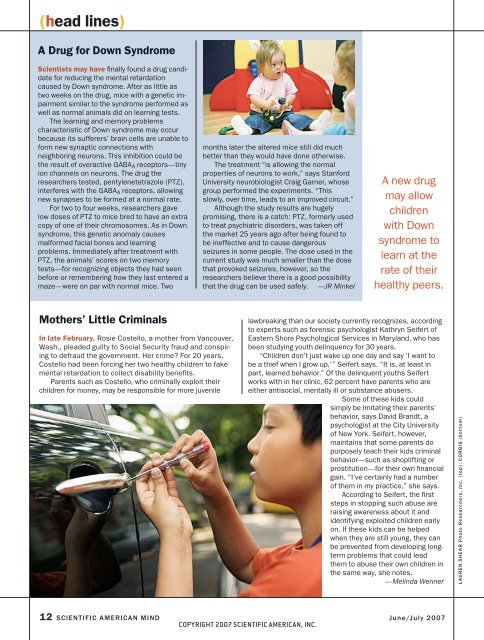Scientific American Mind-June/July 2007
Scientific American Mind-June/July 2007
Scientific American Mind-June/July 2007
Create successful ePaper yourself
Turn your PDF publications into a flip-book with our unique Google optimized e-Paper software.
(head lines)<br />
A Drug for Down Syndrome<br />
Scientists may have fi nally found a drug candidate<br />
for reducing the mental retardation<br />
caused by Down syndrome. After as little as<br />
two weeks on the drug, mice with a genetic impairment<br />
similar to the syndrome performed as<br />
well as normal animals did on learning tests.<br />
The learning and memory problems<br />
characteristic of Down syndrome may occur<br />
because its sufferers’ brain cells are unable to<br />
form new synaptic connections with<br />
neighboring neurons. This inhibition could be<br />
the result of overactive GABAA receptors—tiny<br />
ion channels on neurons. The drug the<br />
researchers tested, pentylenetetrazole (PTZ),<br />
interferes with the GABAA receptors, allowing<br />
new synapses to be formed at a normal rate.<br />
For two to four weeks, researchers gave<br />
low doses of PTZ to mice bred to have an extra<br />
copy of one of their chromosomes. As in Down<br />
syndrome, this genetic anomaly causes<br />
malformed facial bones and learning<br />
problems. Immediately after treatment with<br />
PTZ, the animals’ scores on two memory<br />
tests—for recognizing objects they had seen<br />
before or remembering how they last entered a<br />
maze—were on par with normal mice. Two<br />
Mothers’ Little Criminals<br />
In late February, Rosie Costello, a mother from Vancouver,<br />
Wash., pleaded guilty to Social Security fraud and conspiring<br />
to defraud the government. Her crime? For 20 years,<br />
Costello had been forcing her two healthy children to fake<br />
mental retardation to collect disability benefi ts.<br />
Parents such as Costello, who criminally exploit their<br />
children for money, may be responsible for more juvenile<br />
months later the altered mice still did much<br />
better than they would have done otherwise.<br />
The treatment “is allowing the normal<br />
properties of neurons to work,” says Stanford<br />
University neurobiologist Craig Garner, whose<br />
group performed the experiments. “This<br />
slowly, over time, leads to an improved circuit.”<br />
Although the study results are hugely<br />
promising, there is a catch: PTZ, formerly used<br />
to treat psychiatric disorders, was taken off<br />
the market 25 years ago after being found to<br />
be ineffective and to cause dangerous<br />
seizures in some people. The dose used in the<br />
current study was much smaller than the dose<br />
that provoked seizures, however, so the<br />
researchers believe there is a good possibility<br />
that the drug can be used safely. —JR Minkel<br />
A new drug<br />
may allow<br />
children<br />
with Down<br />
syndrome to<br />
learn at the<br />
rate of their<br />
healthy peers.<br />
lawbreaking than our society currently recognizes, according<br />
to experts such as forensic psychologist Kathryn Seifert of<br />
Eastern Shore Psychological Services in Maryland, who has<br />
been studying youth delinquency for 30 years.<br />
“Children don’t just wake up one day and say ‘I want to<br />
be a thief when I grow up,’ ” Seifert says. “It is, at least in<br />
part, learned behavior.” Of the delinquent youths Seifert<br />
works with in her clinic, 62 percent have parents who are<br />
either antisocial, mentally ill or substance abusers.<br />
Some of these kids could<br />
simply be imitating their parents’<br />
behavior, says David Brandt, a<br />
psychologist at the City University<br />
of New York. Seifert, however,<br />
maintains that some parents do<br />
purposely teach their kids criminal<br />
behavior—such as shoplifting or<br />
prostitution—for their own fi nancial<br />
gain. “I’ve certainly had a number<br />
of them in my practice,” she says.<br />
According to Seifert, the fi rst<br />
steps in stopping such abuse are<br />
raising awareness about it and<br />
identifying exploited children early<br />
on. If these kids can be helped<br />
when they are still young, they can<br />
be prevented from developing longterm<br />
problems that could lead<br />
them to abuse their own children in<br />
the same way, she notes.<br />
—Melinda Wenner<br />
12 SCIENTIFIC AMERICAN MIND <strong>June</strong>/<strong>July</strong> <strong>2007</strong><br />
COPYRIGHT <strong>2007</strong> SCIENTIFIC AMERICAN, INC.<br />
LAUREN SHEAR Photo Researchers, Inc. (top); CORBIS (bottom)

















